Chrysanthemums bear single, semi-double, or double flowers heads often in dense clusters. Sometimes the clusters consist of tiny flowers, sometimes growers remove flower buds from clusters to increase the size of the remaining bloom or blooms.
Chrysanthemums are commonly divided into two groups, each with dozens and dozens of cultivars. The two groups are garden chrysanthemums, commonly called garden mums, and the second is exhibition chrysanthemums.
Garden mums are often sold in autumn in garden centers, flower shops, and grocery stores. They have a bushy, branched habit and bear clusters of flowers in a wide variety of colors. Some are upright growing and others look like a rounded cushion or mound. Both bloom over a long period from late summer into mid or late autumn.
Chrysanthemum is a genus of about 20 species of upright, bushy annuals and herbaceous perennials. Botanists attribute most chrysanthemum species to the genus Dendranthema.
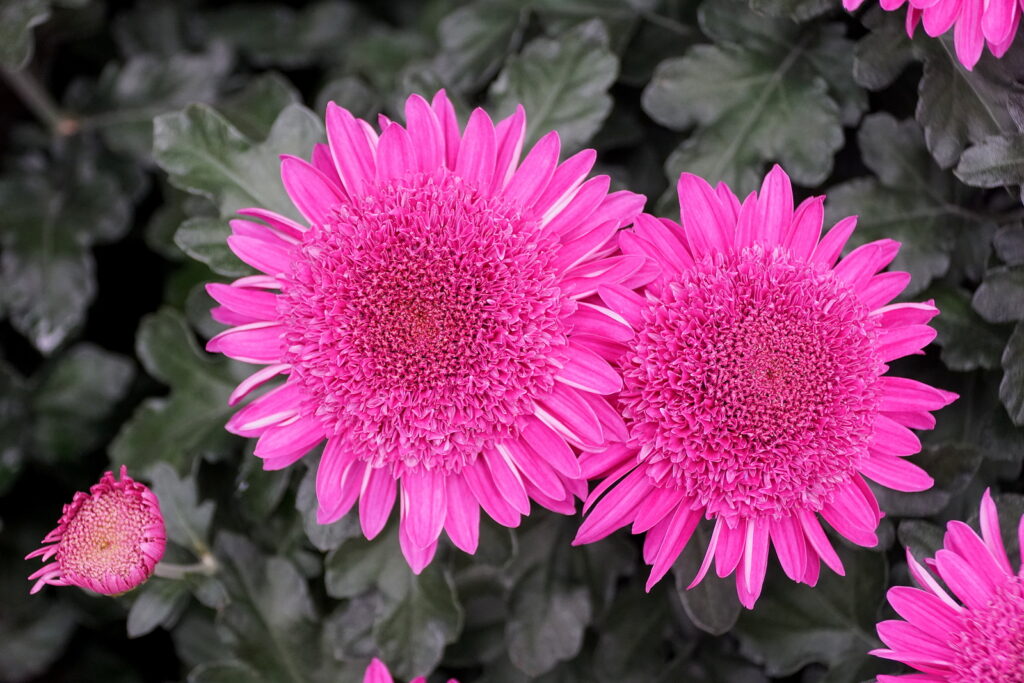
Exhibition chrysanthemums are often categorized according to their flowerhead form. Exhibitors further classify exhibition chrysanthemums by their flowering season–early, midseason, or late, and by whether the plant has been disbudded or not. Disbudding is the removal of some flower buds which allows the remaining buds to grow large flowers.
Chrysanthemums are the standard for late summer and fall garden color. Blooms can be white to pale pink, rose, burgundy, red, golden brown, gold, yellow, and cream. Flower shapes range from button-like heads to incurve, reflex, decorative, pom-pon, anemone, spoon, quill, spider, and brush shapes. Flowers range in size from 1 inch (2.5cm) to 12 inches (30cm) across.
Chrysanthemum plants range in size from 12 inches (30cm) tall to more than 5 feet (1.5cm) tall. Chrysanthemums have lobed, often hairy leaves.
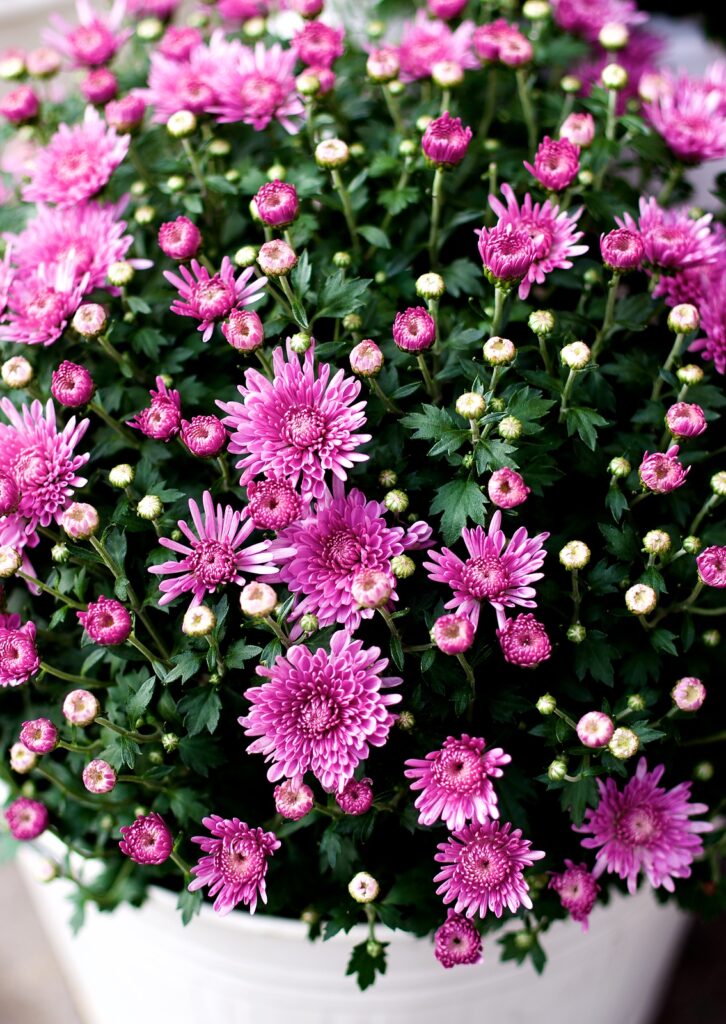
Get to know Chrysanthemums
- Plant type: Hardy perennial treated as an annual
- Growing Zones and range: All zones
- Hardiness: Plants commonly die back in winter but there are cultivars for far northern gardens
- Height and width: 6 inches (15cm) to 5 feet (1.5m) tall; 8 to 36 inches (20-91cm) wide; only a few cultivars grow to 5 feet tall
- Foliage and form: Plants have stout stems and lobed, hairy leaves up to 3 inches long.
- Flowers: Flower range from 1 to 12 inches (2.5-30cm) across; from button-like heads to pom-pon and spider-like blooms
- Flower colors: Almost all colors except blue; pink, red, bronze, orange, yellow, cream, white
- Bloom time: Fall; can bloom year-round in warm-weather regions
- Uses: Mixed border or cut flower garden; mass in groups
- Common name: Chrysanthemum, garden mum
- Botanical name: Chrysanthemum x morifolium
- Family: Asteraceae
- Origin: Annual species are native to the Mediterranean region; perennials are native to North and Central Russia, China, and Japan.
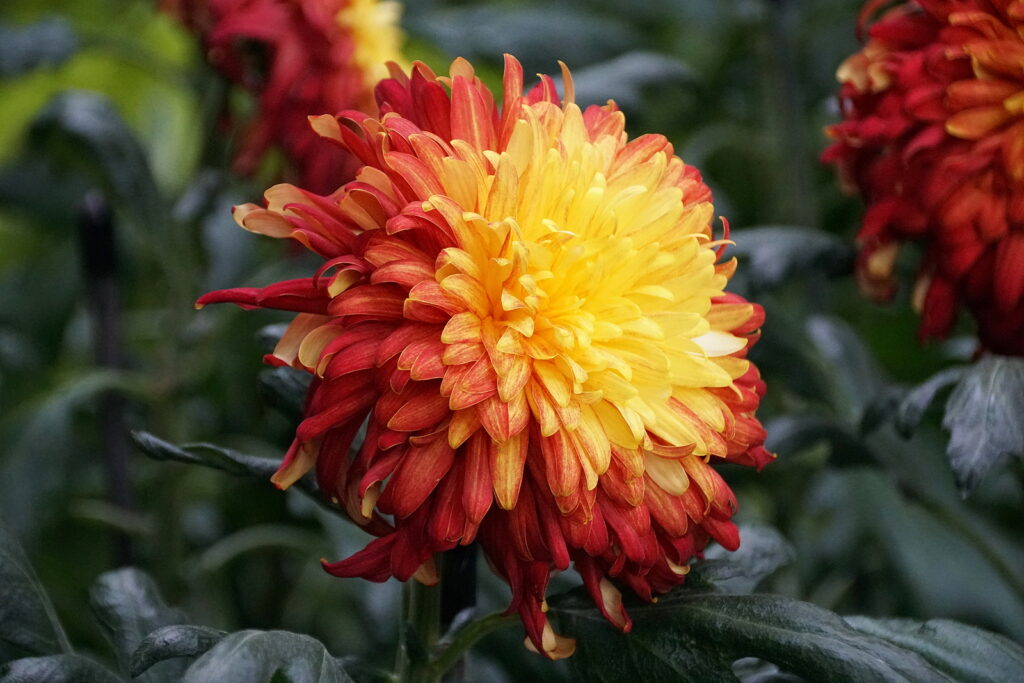
Types of Chrysanthemum flowers
- Chrysanthemum flowers come in a variety of forms: single, anemone, pompon, incurved, reflexed, spider, decorative, and spoon.
- Chrysanthemum flowers are made up of two parts: the center of the flower, or the disk, and the petal-like parts, called rays.
- Single flowers are daisylike and have up to five rows or rays surrounding a flat disk.
- Anemone flowers resemble the single flower, except that the disk is hemispherical or tufted.
- Pompons have rays that curve inward to form a globular flower head and usually hide the disk.
- Incurved flowers have broad rays that curve inward and overlap to form a globular hear; the disk is hidden.
- Reflexed flowers have rays that curve outward and form a flatter flower head than the pompon.
- Spoon flowers have rays with spoon-shaped tips.
Where to plant Chrysanthemums
- Grow chrysanthemums in full sun to light shade.
- Plant chrysanthemums in humus-rich, well-drained soil.
- Chrysanthemums prefer a soil pH of 6.5 to 7.5.
Chrysanthemum uses and companions
- Use Chrysanthemum coccineum in informal plantings and cottage gardens.
- Use Chrysanthemum nipponicum in beds and borders; use it in informal plantings and seashore gardens.
- Use Chrysanthemum weyrichii as edging and in autumn gardens.
- Use Chrysanthemum rubellum in informal and cottage gardens. Combines well with blue and purple flowers.
- Use Chrysanthemum superbum in mass plantings in informal borders, as edging or middle-of-border plant; use as a cut flower.
- Good garden companions for Chrysanthemums include Hemerocallis, Monarda, Nepeta, Physostegia, Sedum spectabile, Solidago.
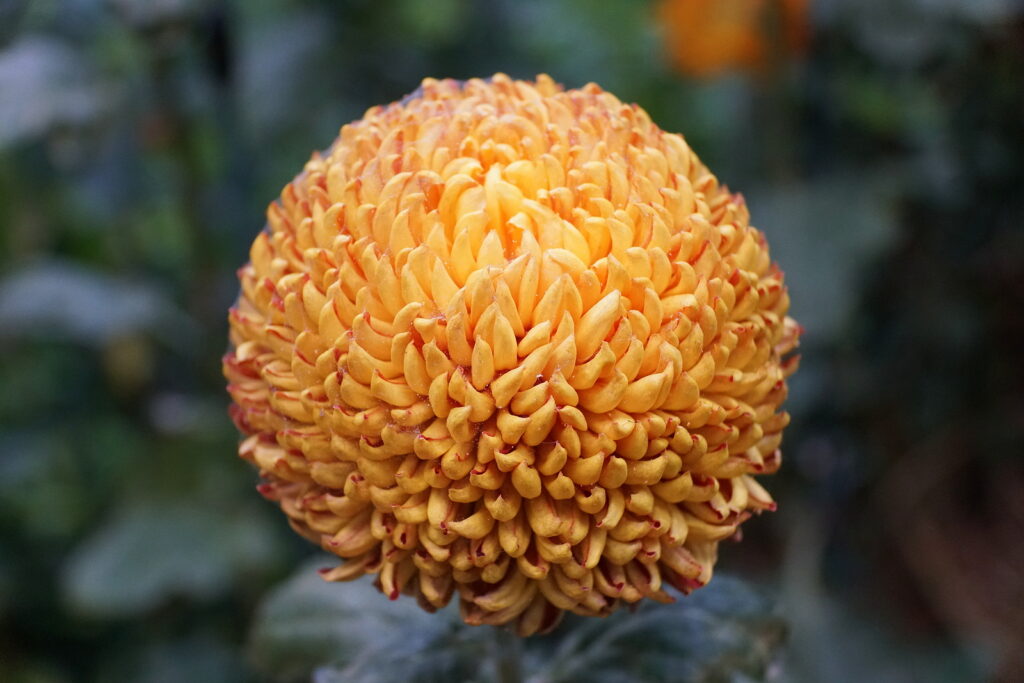
When to plant Chrysanthemums
- Set chrysanthemums in the garden in spring or fall. The best selection of new starts is available in autumn.
- Start chrysanthemum indoors in spring about six weeks before the last frost.
- Sow seeds outdoors or set out transplants in early spring, in fall in mild-winter climates.
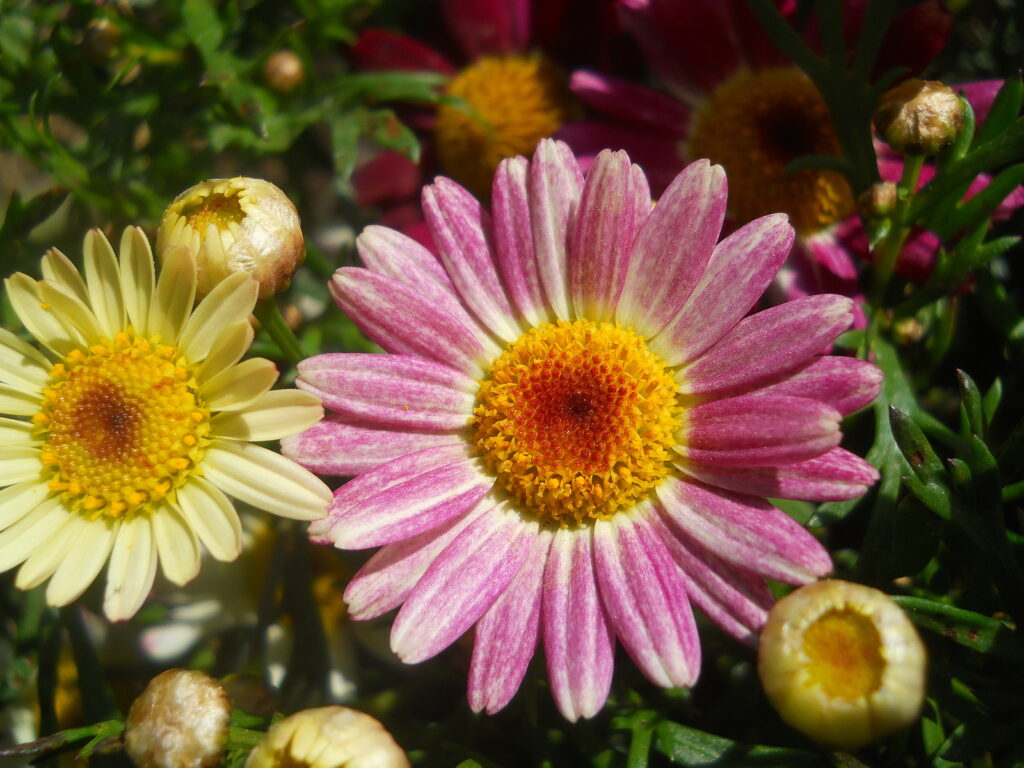
Planting and spacing Chrysanthemums
- Sow seeds indoors in six-pack or pots of sterile seed starting mix at 60° to 70°F (15.6°-21°C); in Zones 9-11, sow seeds in late fall. Start seeds in bright sunlight or under fluorescent light.
- Transplant seedlings to the garden when they are 6 inches (15cm) tall when they have at least four to six leaves.
- Sow seed outdoors in spring or summer; sow seed 1/8 inch deep.
- Space chrysanthemums 18 to 36 inches (45-91cm) apart
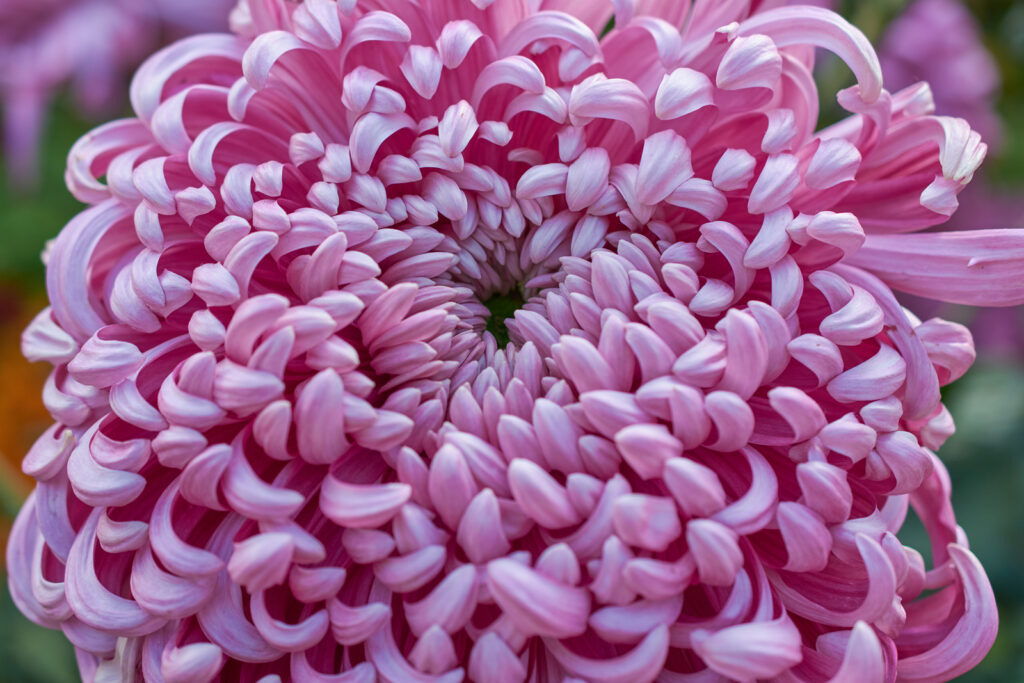
How to water and feed Chrysanthemums
- Chrysanthemums do best if the soil is kept evenly moist.
- Fertilize chrysanthemums with an all-purpose fertilizer every six weeks or so through the growing season.
- Boost blossoms with high phosphorus and potassium fertilizer such as 5-10-10.

Chrysanthemum care
- Mulch in summer to conserve soil moisture and keep the shallow roots moist.
- Mulch around chrysanthemums in winter to protect shallow roots. Very cold winters can kill roots, especially in Zones 4-6.
- Stake tall varieties; use peony hoops to tie them to wooden stakes.
- Cut back foliage in spring to encourage new growth.
- Pinch the stems once or twice in early summer to promote compact growth.
- For larger flowers, disbud (remove side buds near a central bud) for larger flowers; disbud before buds are 1/4 inch wide.
- Protect chrysanthemums in winter by mulching around plants with chopped leaves; pull back mulch in spring after the last hard frost so that new shoots can emerge.
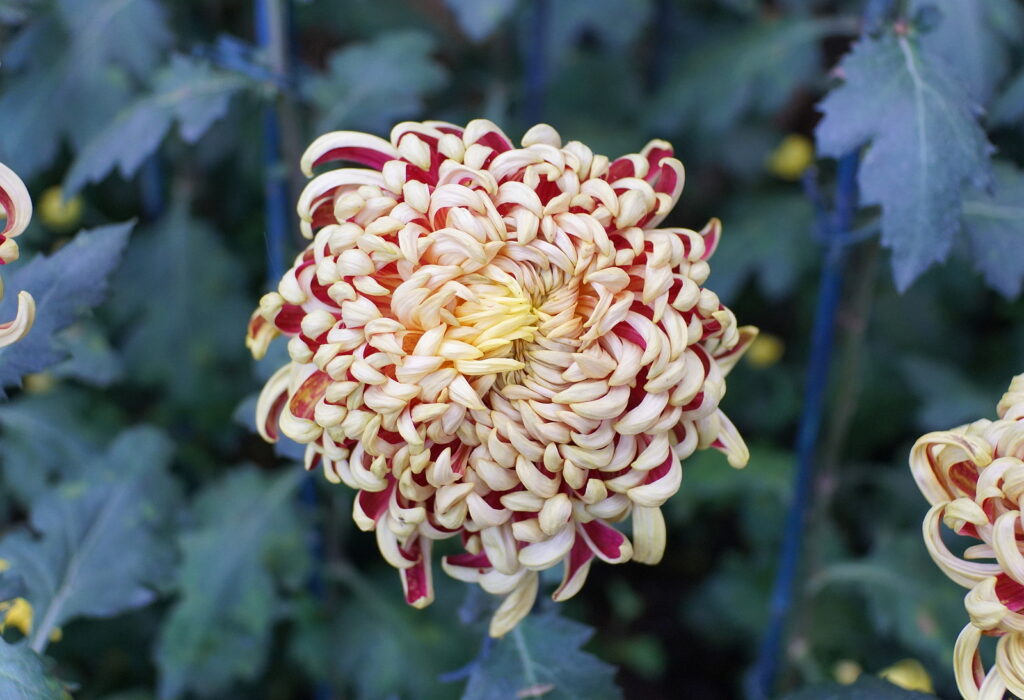
Growing Chrysanthemums as a houseplant
- Chrysanthemums for the house are commonly purchased when they are already in bud or bloom; it is difficult to force a chrysanthemum into bloom indoors.
- Chrysanthemums produce foliage when days are more than 14.5 hours long; they bloom when days are less than 14.5 hours long.
- Place potted Chrysanthemums indoors with average temperature, bright light, and high humidity.
- The potting medium should be rich; keep it evenly moist at all times.
- Chrysanthemums in bloom do not require fertilizer.
- After an indoor chrysanthemum has finished blooming it can be discarded or transplanted into the garden. Chrysanthemums transplanted to the garden in spring are more likely to survive.
Chrysanthemum pests and diseases
- Chrysanthemums are commonly problem-free unless the soil or weather is wet. Rainy weather can spoil blooms.
- Aphids, mealybugs, whiteflies, leaf miners, and spider mites may attack chrysanthemums. Spray with insecticidal soap.
- Chrysanthemums can develop rust, leaf spot, root, and stem rot, powdery mildew, botrytis blight, and wilt.
Chrysanthemum propagation
- Chrysanthemum seeds germinate in 8 to 20 days at 68°F (20°C).
- Divide established chrysanthemums in spring when new growth begins. Dig up crowded clumps and gently separate the stems with roots attached. Replant them immediately; plants will reflower in the same year.
- Tip cuttings take in spring will root quickly and may bloom during the same season.

Chrysanthemum varieties
- There are hundreds of cultivars of chrysanthemums.
- Chrysanthemum x morifolium, the florist’s chrysanthemum, was formerly known as Dendranthema x grandiflorum and is sometimes labeled Chrysanthemum x grandiflorum. This is the garden mum or hardy fall mum, also simply called mum. It varies in hight from 12 to 24 inches when sold as a houseplant
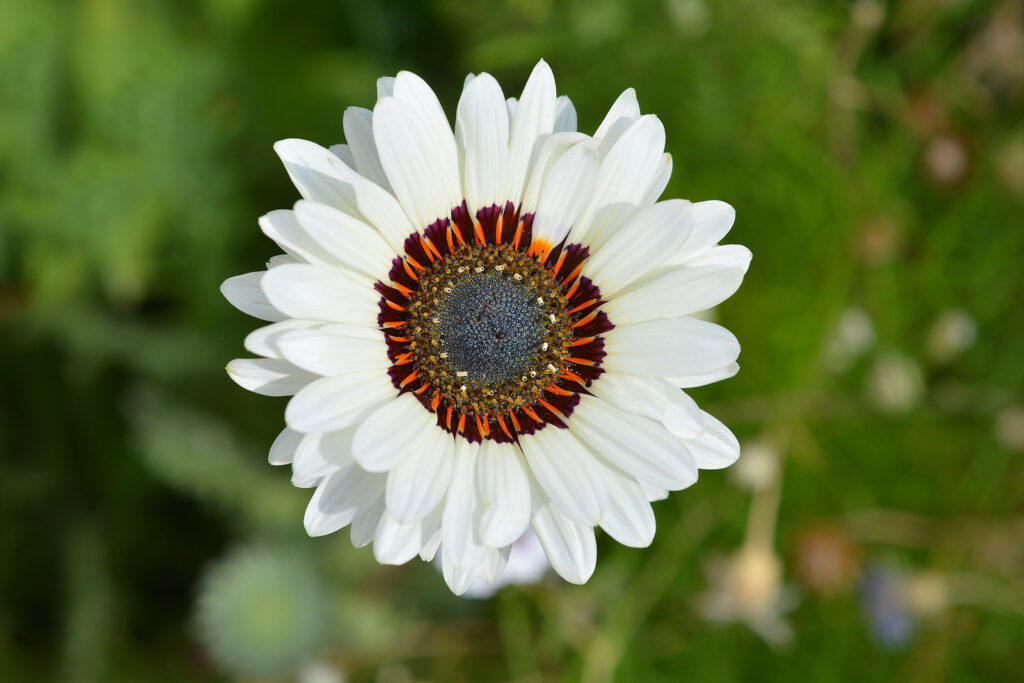
Species and other Chrysanthemums
- Chrysanthemum arcticum, artic daisy. Extremely cold tolerant to -50°F (-46°C); does not thrive in heat; single, yellow-centered white daisies; flowers turn pinkish with age.
- C. carinatum, tricolor chrysanthemum or painted daisy, formerly C. tricolor, is a cool-weather annual with fernlike leaves; it bears 1- to 2-inch pale yellow flowers with golden eyes.
- C. coronarium, crown daisy, garland chrysanthemum, cool-weather annual bears yellow singe or double flowers to 2 inches (5cm) across
- C. coccineum, now Tanacetum coccineum, commonly called painted daisy or pyrethrum; hardy to -30°F (-34°C); long-stemmed daisies come pink shades, red and white; bushy plant.
- C. frutescens, now Argyranthemum frutescens, commonly called Marguerite daisy.
- C. leucanthemum, now Leucanthemum vulgare, commonly called oxeye daisy.
- C. maximum, now Leucanthemum x superbum, commonly called Shasta daisy.
- C. morifolium, this is the familiar florists’ chrysanthemum known as “mums”; reds, golds, orange, bronzes; hardy to -10°F (-23°C); an autum bloomer; many flower forms such as basic daisy to pompon to shaggy to quilled; some are low growing, some taller.
- C. multicaule, mini-marguerites. Small well-branced annuas grow to 12 inches tall.
- C. nipponicum, now Nipponanthemum nipponicum, commonly called Nippon daisy.
- C. pacificum, now Ajania pacifica, commonly called gold and silver chrysanthemum; low growing to 12 inches tall; hardy to -20°F (-29°C).
- C. paludosum, now Leucanthemum paludosum, commonly called creeping daisy or miniature marguerite.
- C. parthenium, now Tanacetum parthenium, commonly called feverfew; feathery bright green leaves; large clusters of sing white daisies less than an inch across.
- C. ptarmiciflorum, sliver lace (one of several plants known as dusty miller). Grow to 8 inches tall with finely cut foliage.
- C. x superbum, now Leucanthemum x superbum, commonly called Shasta daisy; summer-flowering perennial; hardy to -20°F (-29°C); several cultivars; 3- to 4-inch flowers with big yellow centers.
- C. weyrichii, now Dendranthema weyrichii; rhizome spreading plant; single daisies to 2 inches across.















